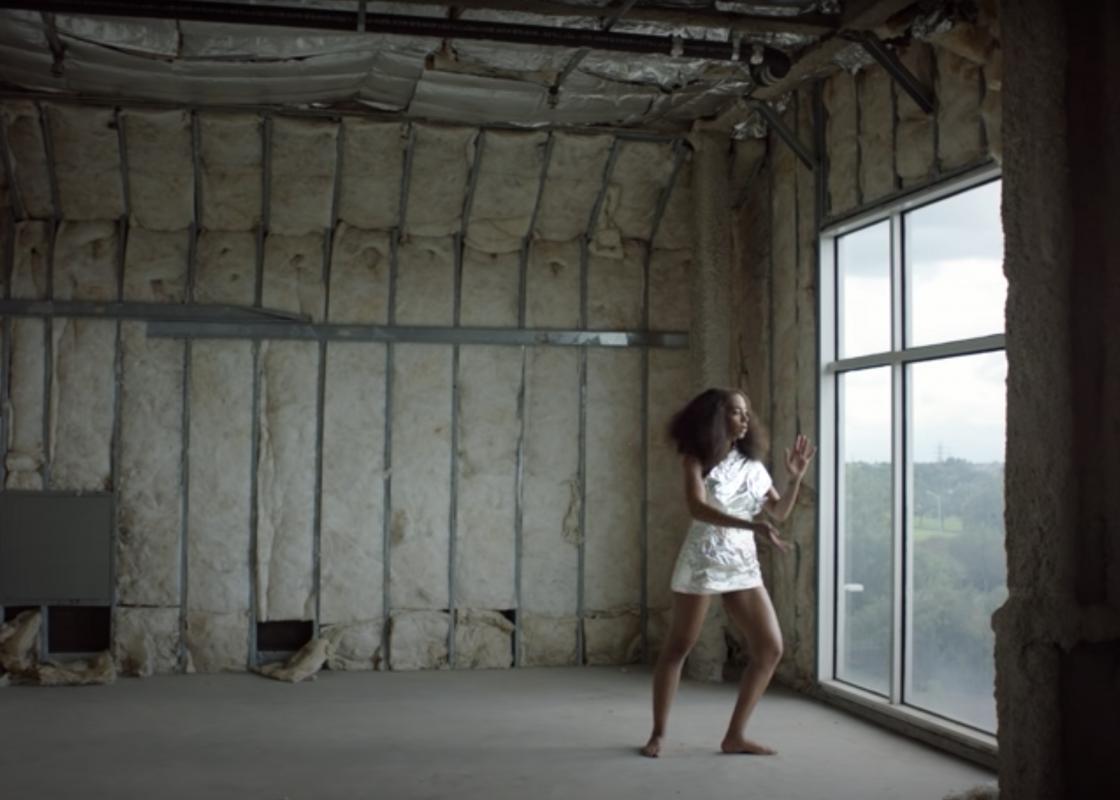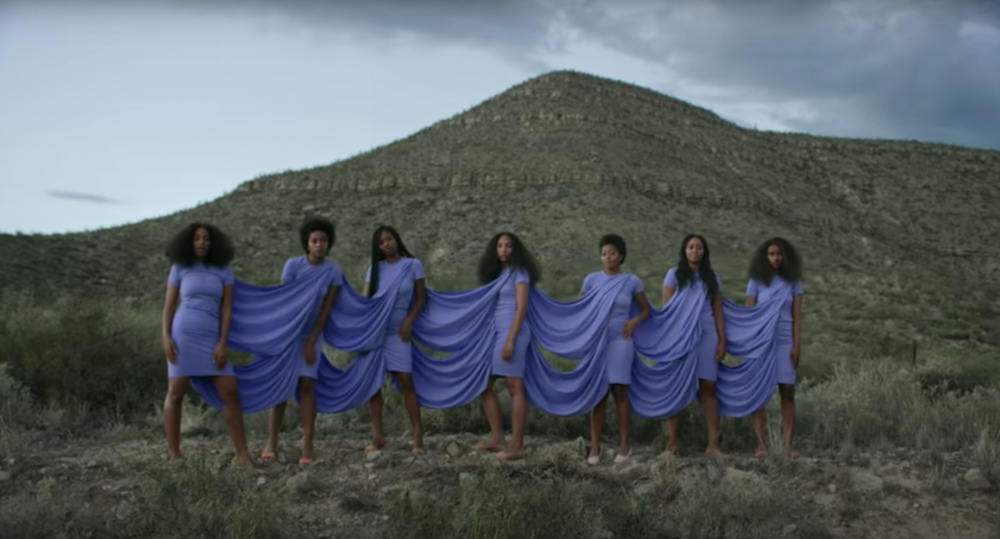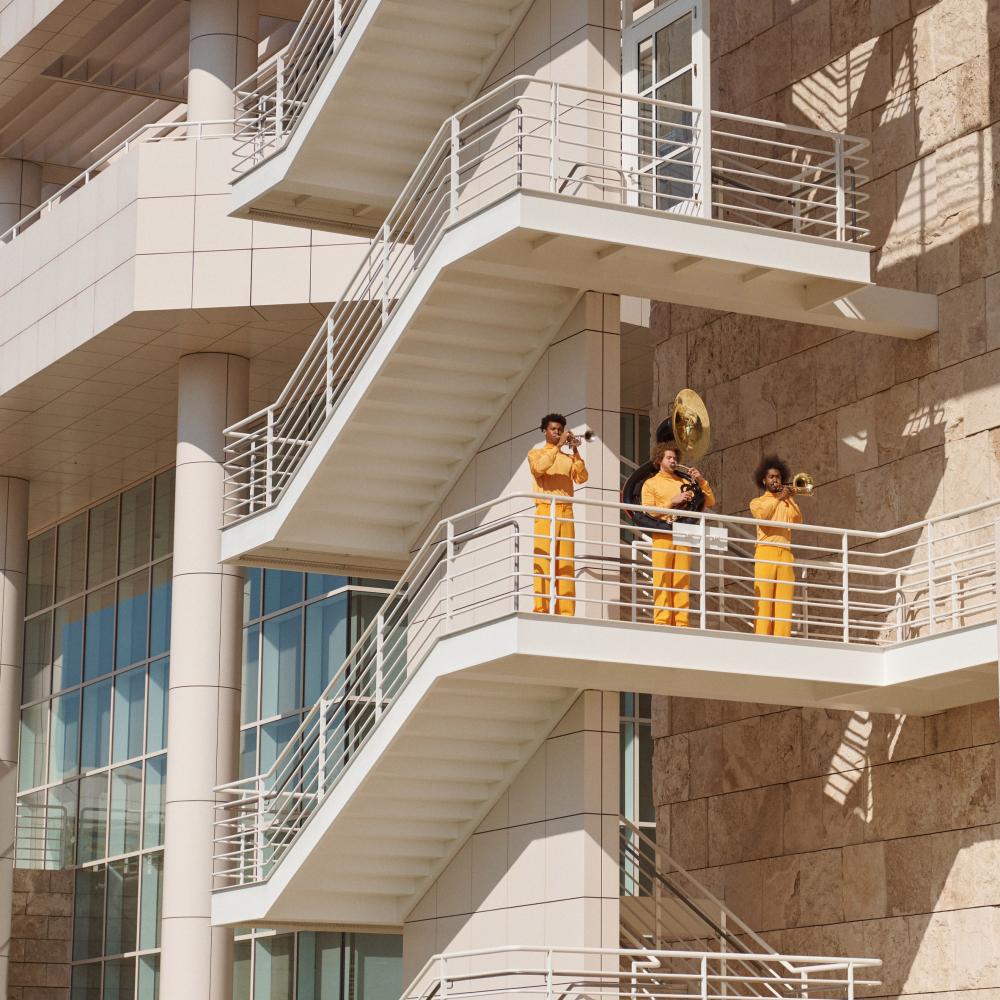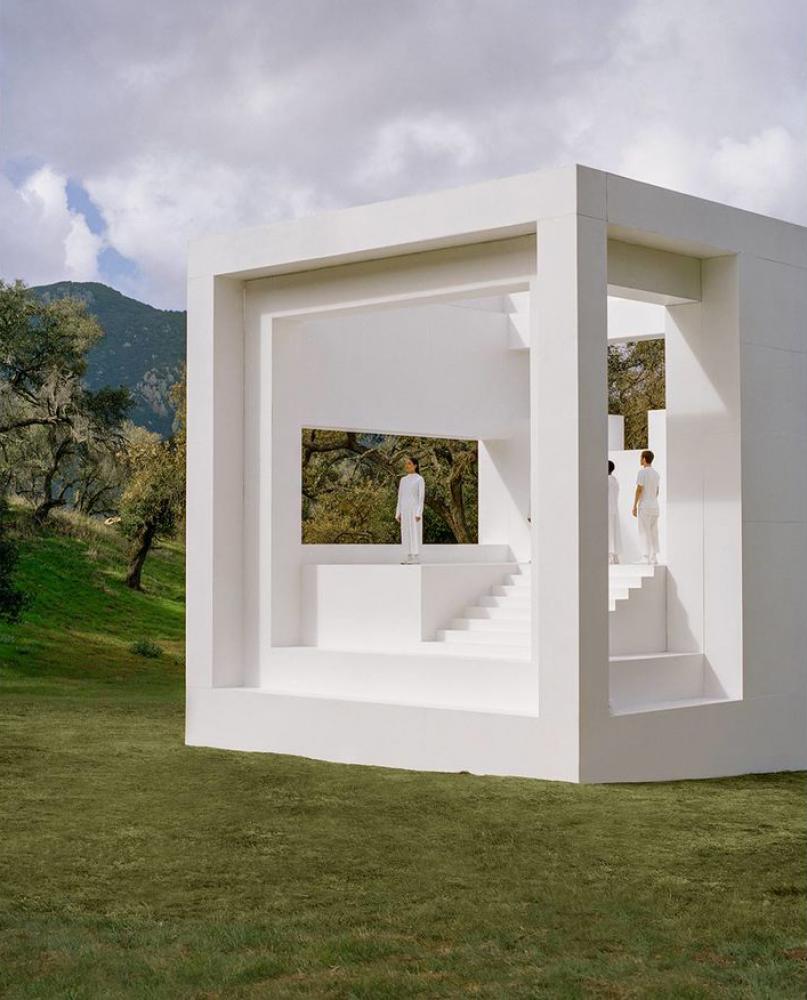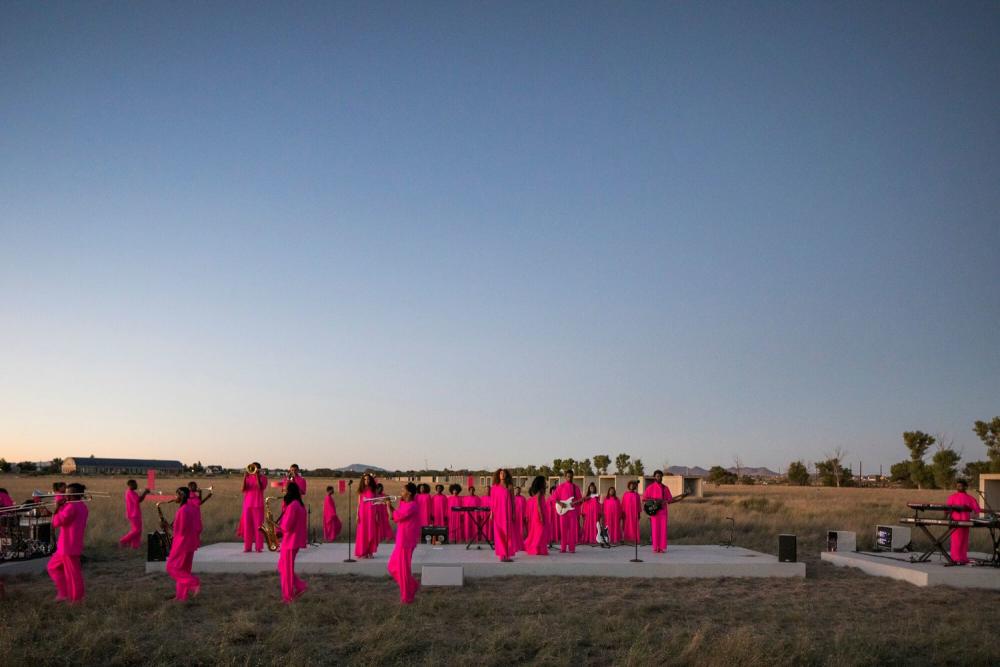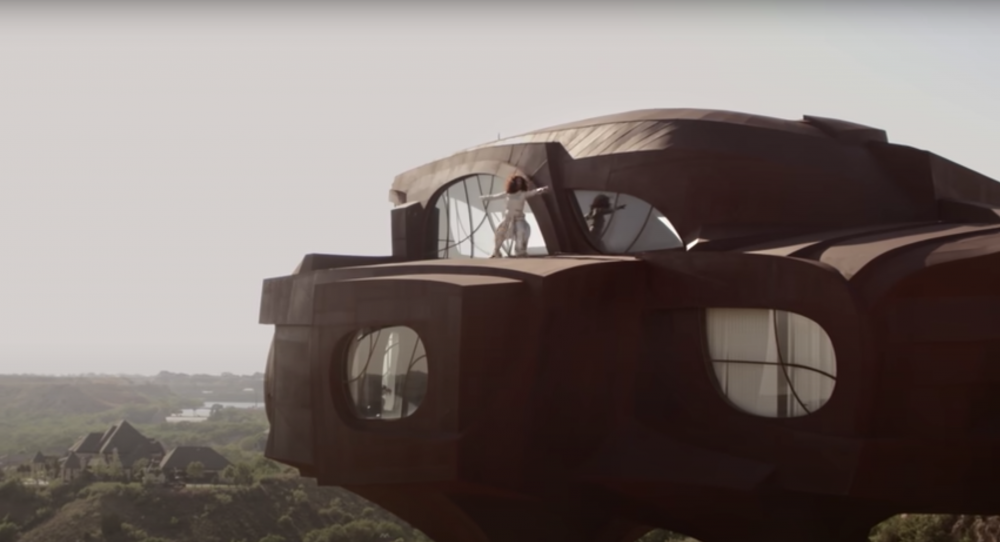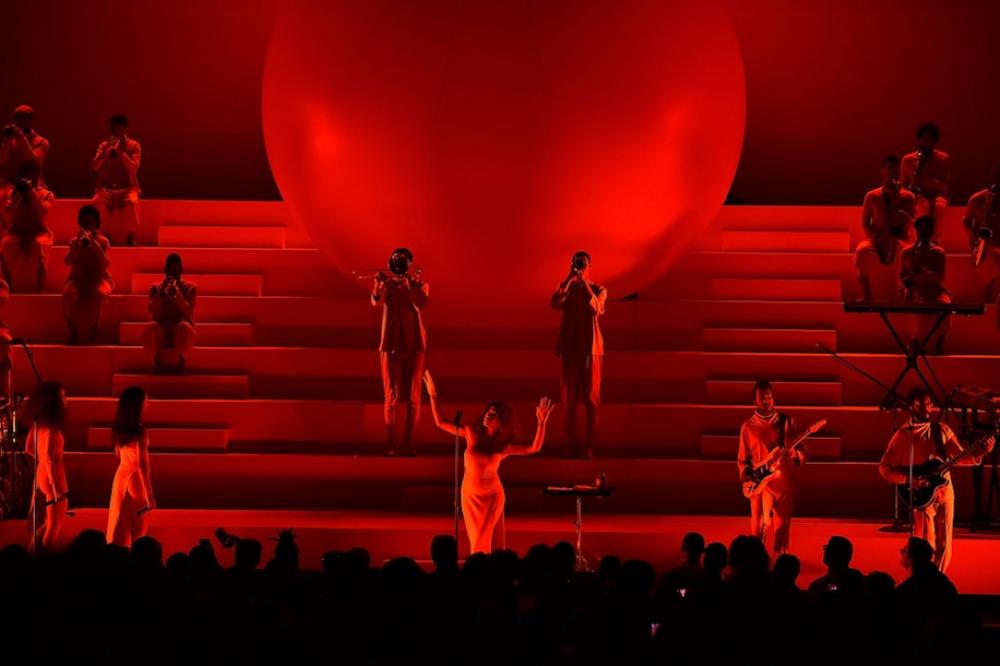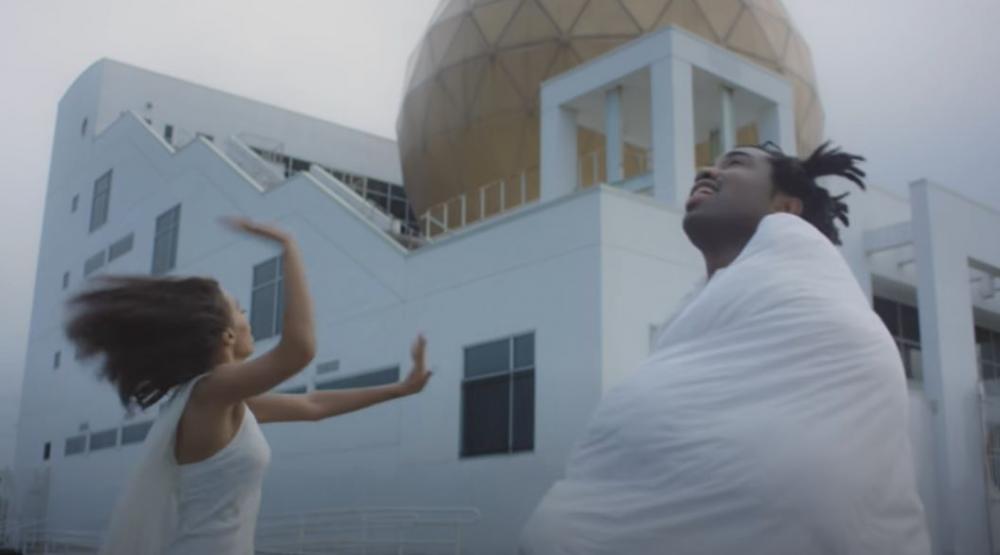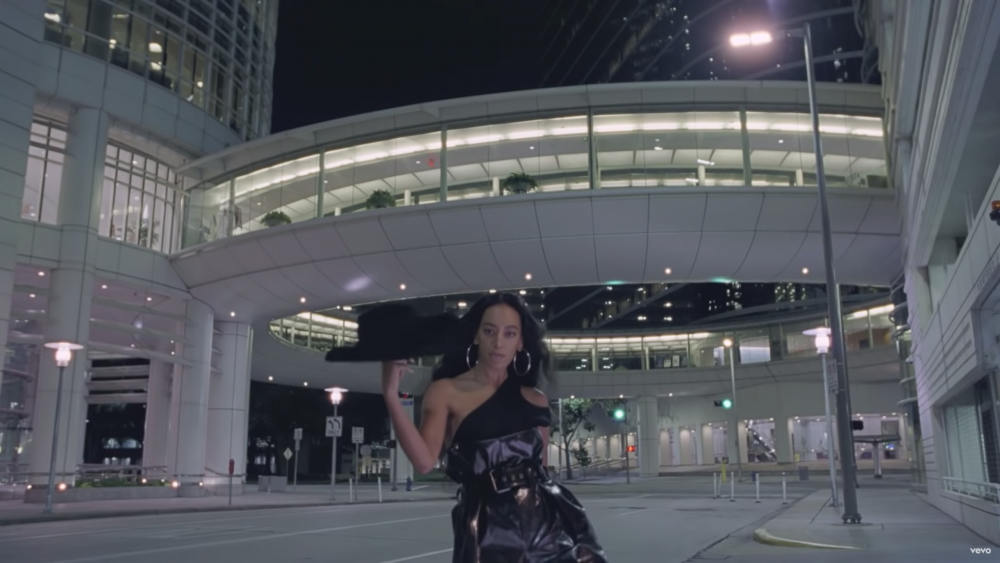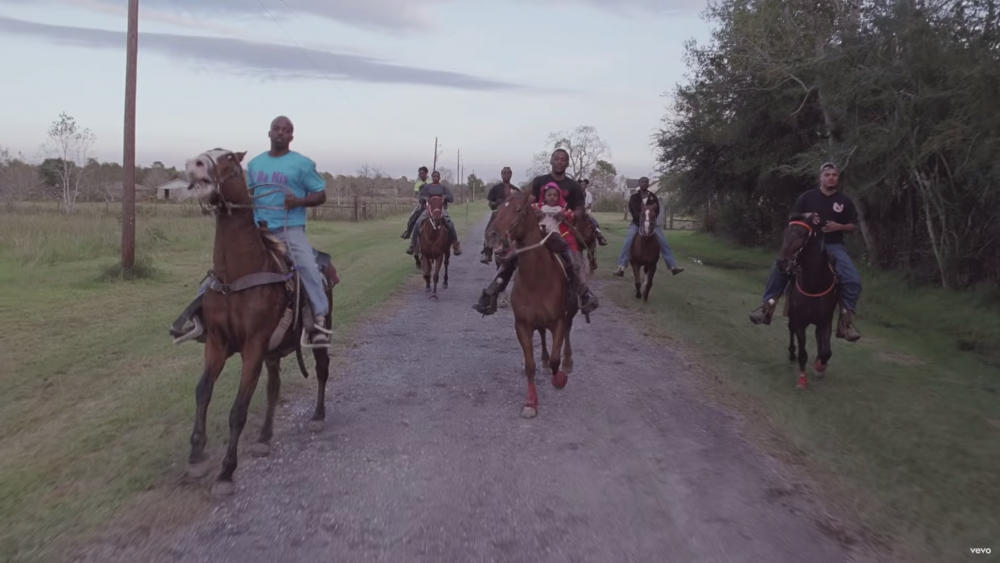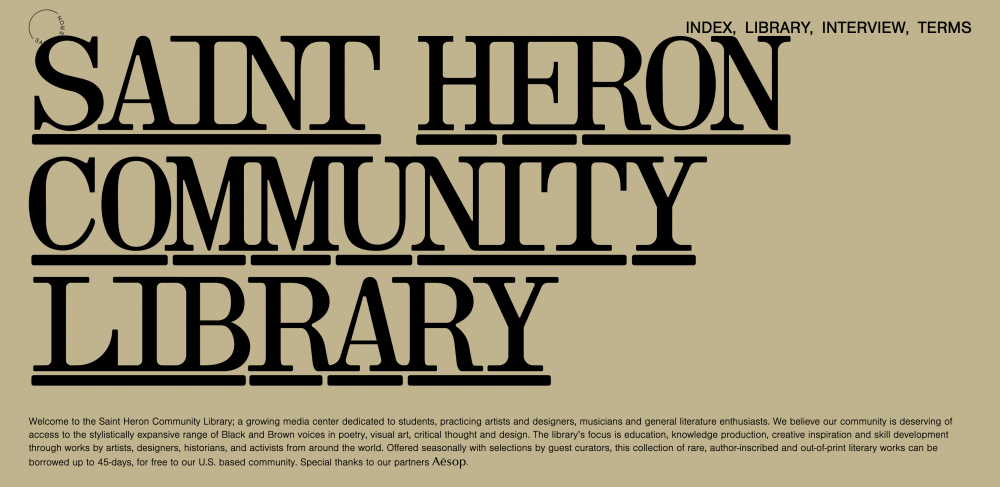In one of Solange’s music videos, we see a palette of muted colors blossom from a gentle lavender into a vivid shade of purple. In another there are dresses made entirely of leaves or yarn, monochrome costumes that unite a cast of dancers, and choreography that repeats simple gestures. We see natural landscapes—specifically the expansive deserts of West Texas and New Mexico—and stage sets that celebrate the reductive geometries favored by minimalist artists. Musically, Solange takes classic tropes of soul and R&B and adapts them to her own style. The result is something familiar yet inventive. Similarly, the visual aspects of her work frame a clear aesthetic lineage while breaking new ground.
Solange is aware of how the environment surrounding her work and audience impacts her viewers. She curates these spaces holistically, with diligence and a clear appreciation for the built environment. In a rare video interview with Trevor Noah on The Daily Show, Solange shared:
I think so much of my work is about world-making. […] A lot of the early years of my life were spent on tour buses and venues and airports and even paying attention to the architectural language in these spaces, these spaces became my home. So a lot of my work is really about creating universes, I’m trying to create cities on stage.
Because of this interest, Solange has a striking ability to pair works of architecture with music and choreography. A look at her music videos and set designs reveals this ongoing interest in architecture and urbanism, but also the historical and social contexts that shaped these fields.
Beginning with her live performance of Scales at the Menil Collection in April 2017, Solange has produced events on location at some of the most impressive arts institutions in the country. Following were performances at the Guggenheim Museum in New York (An Ode To, May 17, 2017) and the Chinati Foundation in Marfa (Scales, October 8, 2017). These locations aren’t just backdrops; through spatial engagement, Solange’s work establishes herself and her performers in venues that are typically understood as fairly white institutions. It’s important to note that her task of world-making begins with making space for Black expression and existence where it hasn’t been openly offered previously. These places aren’t unfamiliar to her; they are environments that Solange knows personally. They’re also spaces where she has experienced institutional marginalization of non-white people firsthand. (In an interview, Solange described how an experience with racism in Marfa inspired past work.)
Beyond the first step of establishing her presence in these institutions, Solange also engages directly, intentionally, even pointedly, with their architectures. In November 2019, a large cast of dancers and musicians performed the piece titled Bridge-s at the Getty Museum in Los Angeles. There, bands of wind instruments were strewn about the site where acoustics had been calculated to converge at the terrace where dancers, singers, and instrumentalists performed. The piece was choreographed for not only the place but also for the time of day, where nuanced warm colors are found in the museum’s limestone façade, the orange and brown costumes of the performers, and in the setting sun. As Solange stated in an interview about the piece, "The purpose for me is to create sound and movement and scenography to develop my own architectural language and to invite the right spaces to coexist with the work."
In April 2018, she partnered with Uniqlo to direct Metatronia (Metatron’s Cube), an interdisciplinary performance piece hosted by UCLA’s Hammer Museum. Set to an experimental music score, the video performance shows dancers in a bucolic hillscape punctuated by minimalist white sculptures. A collaboration with the designer Griffin Frazer, these sculptures are abstractly imaged through simple geometry and a totalizing white finish. We see icons of architectural history (Mies van der Rohe’s Farnsworth House or Peter Eisenman’s House VI, perhaps) compressed and united in these shapes. It should be noted while these references suggest a design intellectualism that possesses an entirely white lineage, there is more to the story. As Arthur Jafa writes in his text “My Black Death,”, abstraction in early twentieth-century European art—dating back to Cubism and German Expressionism, which then evolved into Bauhaus teachings and International Modernism—was set in motion by the plundering of Sub-Saharan Africa’s many visual cultures.
While the environments and set designs of Solange’s performance pieces have an inclination toward contemporary abstraction, her video productions incorporate political, societal, and historical contexts. In her interview with Trevor Noah, she says that she’s
trying to leave behind worlds for young Black girls to discover ten, twenty years from now. [...] Everything that I do I try to center myself and my purpose in the things that I needed to see and be fed as a young girl. […] I am a Black woman so the work will always be through the lens of a Black woman.
Beyond her individual lens, her investigations of world-making are especially powerful because the architectural profession remains overwhelmingly white. Even today, 89% of licensed architects are white; only 2% are Black, and 0.4% are Black women. This means progress can be measured by numbers, as Pascale Sablan does when she notes that she’s the 315th Black female architect to receive licensure in the United States. Changes are underway in organizations and institutions, but we still have a long way to go. Thankfully there are many efforts underway to champion Black voices in architecture, like Dark Matter University or Sablan’s Beyond the Built Environment campaign (Cite is a proud participant in its Say It With MEdia action).
It’s interesting to consider Solange’s spatial practice as it relates to architecture, but her web of inspirations is much wider. For example, Claudia Rankin's 2014 Citizen: An American Lyric was instrumental in Solange's 2016 album A Seat at the Table. As a visual and musical artist, her output includes music, album art, videos, books (including a beautiful publication to accompany A Seat at the Table), performances, concerts, and curation. Her world-making illuminates cultural aspects of architecture and urbanism that have previously been excluded from historical narratives. While Solange might be an “outsider” to architectural discourse, she works in the traditions of Black artistic practices which offer ways of producing and inhabiting space.
Solange’s success stems from the anchoring of her work in her personal experience. In part she does this by utilizing works of architecture from her home state of Texas and her hometown of Houston. As an example, see Solange’s music video for “Cranes in the Sky.” It opens with a series of compositions reflecting her carefully honed aesthetic—natural landscapes, pastel shades of muted colors, and garments that are exceedingly abstract. Then architectural spaces appear. In one scene, the camera focuses on Solange in a lavender silk dress from above, framing her head and shoulders against a sea of red carpet, and then slowly zooms out to reveal that she’s cradled by the spiral ramp inside Ulrich Franzen’s 1968 brutalist Alley Theatre. Another scene shows Solange wrapped in metallic foil inside a construction site, surrounded by exposed metal studs and fiberglass insulation. The video culminates with the artist taking a bow atop an architectural oddity that appears to have fallen from the sky: the Steel House, whose construction outside Lubbock by Robert Bruno began in 1973. This spaceship of a building—and her dancing upon it—mixes referential and futuristic imagery into a single scene and gives a clue to the more pointed intentions to come in her work.
Afrofuturism, a term coined in 1993 by Mark Dery, captures a movement first explored by the musician Sun Ra in the 1950s. It transcends any artistic or musical genre; it is a multifaceted imaginary that inspires visual artists, musicians, designers, and writers. It explores the intersection of technology with the culture of the African diaspora and engages themes like feminism, alienation, and reclamation. Visual themes in Afrofuturism often depict figures wearing Maasi or Ndebele neck ornaments, but instead of the typical headdress, a UFO might adorn their crown while celestial bodies float in the background. Current pop culture examples of Afrofuturism include the successful Black Panther film series or Beyoncé’s music video for “Sorry”, in which the singer—Solange’s older sister—dances in an almost robotic manner while her hairstyle mimics that of Mangbetu women in what is now the Democratic Republic of the Congo.
Solange refrains from using such overt imagery, but an undercurrent of Afrofuturism can be seen in her work, like her bow atop Bruno’s earth-anchored spacecraft. At times Solange pays direct homage to Sun Ra: in Orion’s Rise, a performance from 2017, Sun Ra’s band—the Sun Ra Arkestra, directed by Marshall Allen—was a musical guest. The stage set from her 2017 tour featured two pyramids framing a massive horizontal staircase, while a giant orb is suspended overhead. Everything is saturated by red lights; periodically a beam of white light descends, ready to abduct everyone on stage. It could be noted that the basic geometries found on the stage sets echo architectural trends, as simple shapes have come back into fashion. Solange’s set designs recontextualize these geometric themes that are common architectural moves but situates them within the domain of Afrofuturism.
The video for “Don’t Touch my Hair” (released the day after the “Cranes in the Sky” music video) hints at Afrofuturism with a surprising cameo from Houston’s mysterious Chong Hua Sheng Mu Holy Palace. The abandoned Taoist temple along Brays Bayou acts as a background for her and Sampha, both wearing atypical garments in pure white that speak to the white of the stucco walls behind them. Sampha is cloaked in something like a down comforter which somehow mimics the puffy insulated suits worn by astronauts, while Solange wears a sheer white cape which blows in the wind behind her. Another scene in the video includes a neoclassical pavilion (this time in New Orleans, Solange’s adopted home) where Solange flaunts finger waves and 1960’s mod drop earrings, sporting track pants that are the exact same color of the columns that surround her. The styling of the costumes and the choice of filming locations fold together various histories and time periods. While one scene feels like the cultish admiration of futuristic constructions, the other harkens back to a past era. This juxtaposition instills a sense of permanence through the participation of two archetypal geometries: the columned façade and the geodesic dome.
Solange’s investigation of Houstonness reached its pinnacle with 2019’s When I Get Home. In previous videos, Solange used sly references for those acquainted with Texas architecture. But When I Get Home is largely a portrait of Houston, the “capital of the south,” the energy capital of the world, and one of the last bastions of the American frontier. The film opens with her inside the Rothko Chapel (pre-renovation), with the delicate sunlight from above captured in the crystal covered fringe of her dress. We see the skyline of downtown Houston—then, Solange dances in a cowboy hat in front of I.M. Pei’s City Hall in Dallas. Later she twirls that same hat on her finger below the circular skywalk of 1400 Smith Street (formerly Enron’s headquarters, now home to Chevron). Vernacular architecture also makes an appearance, as the camera follows a man riding his horse down a street lined with shotgun houses, rounding out a thorough portrait of the city and its many facets.
Solange’s hometown focus suggests a more specific ideological framework: Afrosurrealism, a term first used in 1974 to describe the work of African American writer and poet Henry Dumas. It’s distinct from Afrofuturism, but the two are often conflated. While the latter imagines a future yet to come, the former reframes a lived experience, both in the past and in the present. In his Afrosurreal Manifesto, D. Scot Miller wrote that "Afro-Surrealists restore the cult of the past," and "presuppose that beyond this visible world, there is an invisible world striving to manifest, and it is our job to uncover it." This notion of an invisible world is critical to the understanding of Afrosurrealism because the true history of the Black experience has been repeatedly expunged from our national narrative.
For example, it wasn’t until the 2016 film Hidden Figures that many became aware of the contribution by Black women to NASA. In When I Get Home, a brief still of a wall covered in the awards and portraits of these astronauts highlights the accomplishments of this Black community. Another scene shows model and Twitter royalty Zolarmoon repairing a spaceship console and then dragging it across the New Mexican desert. This styling might seem outlandish and arbitrary, but with an inclusive historical pretext we can instead read it as the symbolic celebration of hidden truth.
Touching on another aspect of buried Black culture, we see a group of Black cowboys and cowgirls riding horses; one has a baby in his arms. We also see a group of Black cowboys riding broncos among the vast west Texas landscape. This scene surprises some viewers because many Americans are still unaware that one in four cowboys were Black and that the Lone Ranger was likely a Black man. Yet even today some households in Sunnyside, a predominantly Black neighborhood south of downtown Houston, stable horses in their backyards.
These scenes may feel foreign to some, but When I Get Home showcases lived experience: it celebrates very real Black experiences which have been regularly erased from this country’s historical narrative. These scenes may seem like imagined projections to some, but from Solange’s perspective one could imagine her borrowing the words of Frida Kahlo, who once said: “I’m not a surrealist. I just paint what I see.” What Solange created is a depiction of Houston’s Black community, in turn showing how the city itself is a stunningly apt setting for the exploration of Afrosurrealism.
Architects, designers, and urbanists should learn from Solange’s work. Her productions showcase a remarkably synthetic creative mind who realizes powerful and elegant pluralities. It’s important to recognize the power of seeing and centering Black people in spaces where there isn’t an established Black community. (West Texas’s Presidio County, which includes Marfa, is 0.44% Black, for example.) It’s even more important in places where racism is expressed openly and fearlessly. Solange’s world-making dissolves the boundaries between places and publics. It’s remarkable to witness an artist pulling together so many seemingly disparate elements to craft new, coherent worlds of possibility for Black people.
What’s next for Solange appears to be a shift toward new forms of curation, archiving, and digital storytelling. Her organization Saint Heron recently announced its intention to present the works of creative voices from Black and brown communities. (Its website currently offers an online community library of books which express “the stylistically expansive range of Black and Brown voices in poetry, visual art, critical thought and design.”) The institution will house a permanent collection, an online dossier, a non-profit library, and host gallery exhibitions. This focus suggests the arrival of an outfit where artists from underrepresented communities have agency in preserving their histories. Saint Heron’s creative visions reflect the truths of their creators. And these visions might illuminate things that have always escaped us, until now.
Sheila Mednick is a designer and writer living and working in San Francisco. A native of California, she studied the History of Art and Visual Culture at UC Santa Cruz and architecture at Columbia University and Rice University. She has practiced architecture across the United States and in Europe.


